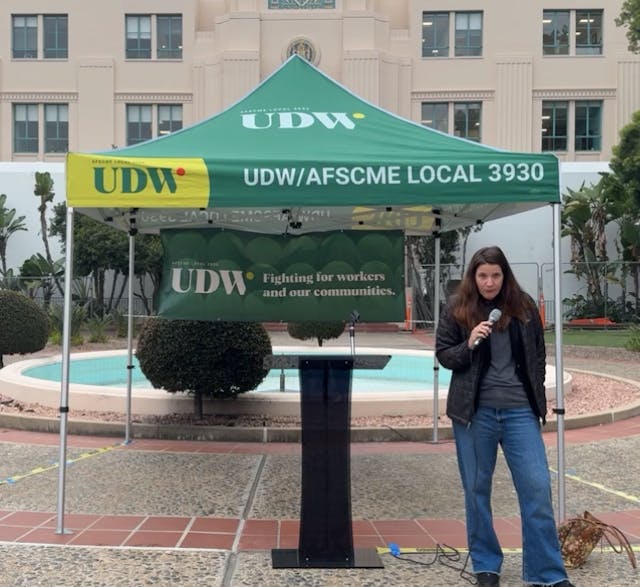20 Years of Border Femicide
Frontera NorteSur
With a warm smile beaming across her face, Ana Alarcon recalls waiting for her daughter Esmeralda at the bus stop every day. In the proud remembrance of her mother, Esmeralda Juarez Alarcon was a busy and no-nonsense 16-year-old who wanted to help her family move up in the rough-and-tumble world of Ciudad Juarez.
The teen had studied accounting and secretarial skills at one private school, sold clothes at the Mercado Reforma in the border city’s downtown and still found time to study in the evening at a branch of the private ECCO computer school. Esmeralda was so good with computers that the ECCO staff considered her a “brilliant” student and had the teen instructing other students, Alarcon said.
“She was one of the best students with straight A’s. All the teachers congratulated me for having one of the best students,” Alarcon said in a recent interview.
On January 7, 2003, the day after Three King’s Day, Esmeralda did not come home. A few weeks later, in February, she was found bound and murdered along with two other young women at Cristo Negro, an isolated site on the edge of Juarez. An autopsy determined that Esmeralda was killed about a week after she disappeared, Alarcon said.
More than ten years later, the murders of Esmeralda Juarez and the other Cristo Negro victims remain unpunished.
“Nobody knows anything. There are no advances, no leads,” Alarcon lamented of the status of the murder investigation.
According to a 2005 book by El Paso author and journalist Diana Washington Valdez, at least six female murder victims were recovered from Cristo Negro between October 2002 and February 2003, though Chihuahua state authorities attempted to keep the grisly findings under wraps. In the map of gender violence, Cristo Negro was just one of numerous, secret graveyards in the Paso del Norte borderland.
Together with Ana Alarcon, Velia Tena Quintanilla shares pain, sorrow, memories, and uncertainties. Quintanilla described her daughter, Rosa Isela Quintanilla, as a shy 14-year-old who didn’t “trust any old person” while growing up in Juarez in 1995.
“She was very serious, hardworking, clean and a homebody who was very loving with her family and close to her brothers and sisters,” Tena said of her daughter.
For a couple of years, Juarez had been on edge because of the disappearance and sex-related murders of girls and young women.
A serial killer was suspected, and Chihuahua state law enforcement authorities cried case solved in October 1995 when they detained an Egyptian national, Abdel Latif Sharif Sharif, linking the foreigner who spoke little Spanish to multiple women’s murders.
But on December 3, 1995, Rosa Isela Quintanilla vanished after leaving the family home. On December 16 she was found bound, raped and strangled to death close to Chihuahua state law enforcement installations in Juarez.
“I told her to take care of herself, to not go out alone,” Tena recalled. “Unfortunately, the day she went out alone is the day they took advantage of it to cart her away.”
Nearly 20 years later, Rosa Isela Quintanilla’s murder remains an unsolved crime.
The murders of Esmeralda Juarez and Rosa Isela Quin-tanilla form part of a long series of gender crimes that first became a major issue in 1993 when Ciudad Juarez women’s activists like Vicky Caraveo and the late Esther Chavez Cano began protesting killings that would become known as femicides.
A pattern in numerous crimes was evident early on: slim and long-haired young girls and women would seemingly vanish from the face of the earth, some of them later turning up murdered at sites that served as dumping grounds – Lote Bravo, Lomas de Poleo, Campo Algodonero and Cristo Negro.
Many of the victims were last reported alive in downtown Juarez, a gritty and maze-like district of sleazy bars, pawn shops, crowded markets, fast food joints, private schools and other businesses. To an extent, the disappearances and killings were characterized in the international media as “the maquiladora murders.”
While some of the victims did indeed work in the foreign-owned factories called maquiladoras, many others were students or downtown workers, said Dr. Cynthia Bejarano, professor of criminal justice at New Mexico State University.
“In actuality, we’re talking about girls, and in some cases they are like children,” Bejarano told FNS.
Bejarano, who has written and co-edited numerous articles and books on international gender violence, said another common denominator united the victims: social class. “They either lived in poverty or abject poverty,” the border scholar said.
An important contextual element in violence against women in Juarez, Bejarano continued, is the city’s border location, a geographic and politically demarcated fact of life that makes it a “volatile” place riddled by “shadow economies” revolving around illegal drugs, arms dealing and human trafficking.
Fast forward 20 years after the Juarez women’s murders became a public issue and some things have changed while a lot hasn’t. Despite civil society anti-violence movements and government-sponsored reforms, the list of victims is longer than ever.
In the late 1990s, when about 200 women had been reported murdered, the national and international outcry was so loud that outside agencies like Mexico’s National Human Rights Commission and the United Nations launched investigations and issued recommendations, many of them sharply critical of local and state authorities.
The initial probes were followed by a slew of official and non-official investigations variously carried out by Amnesty International, the Mexican federal attorney general’s office, the Inter-American Commission on Human Rights and others. Hundreds of more recommendations for governmental reforms and actions flowed, but the killings and disappearances only mounted.
Precisely how many women have been murdered and/or forcibly disappeared during the last 20 years will likely never be known since some slayings go unregistered, record-keeping is incomplete and different law enforcement agencies report different statistics.
The causes of homicides varied, ranging from suspected gangland vengeance to robbery and to sexual assault. In her writings, Monarrez has distinguished between “organized” femicides, such as the ones exposed at Cristo Negro and other mass dumping sites, and “unorganized” femicides consisting of systemic, individualized gender-based killing.
Women’s homicides soared during the period of “hyper-violence” linked to the cartel wars that ravaged Juarez from early 2008 to 2012, and many murders could be connected to underworld rivalries as opposed to sex-related violence, though it is often difficult to determine exact motive since most murders have never been thoroughly investigated.
Longtime women’s activist Vicky Caraveo, who served as the first director of the official Chihuahua Women’s Institute, is disheartened by the turn of events. Asked in a recent interview if she ever imagined herself back in 1993 struggling against the same issues 20 years later, Caraveo gave an emphatic no.
“I thought there was going to be a substantial change,” she said, adding that women’s demands remain the same as two decades ago: “Return our daughters, or justice in the case of a murder.”
Currently the coordinator of Mothers in Search of Justice, a non-governmental organization of victims’ relatives, Caraveo said violence against women extends beyond the serial-like disappearances and murders and touches all walks of life. For instance, Caraveo’s group has received recent reports of women threatened and young girls raped with impunity.
“We’re very frustrated, because violence against women hasn’t diminished, it’s increasing,” Caraveo said. Women, she insisted, are “expendable” and “replaceable” in contemporary society. “We’re at the mercy of what men can do to us.”
In Juarez, where official campaigns are underway to revive the city and project a new face to the world through mega-projects and new monuments, the femicide issue has largely been forgotten, Cara-veo asserted.
“Juarez needs everything. We need pretty parks, but they don’t mean you should lose sight of the other reality of Juarez, the insecurity of women,” she argued.
Separately, Bejarano offered a similar analysis, contending that attention on the women’s murders has been submerged in the broader violence that’s bludgeoned the city.
In 2013, however, a flurry of legal activity has swirled around the arrests of 12 suspects in the disappearance and murder of 13 young girls between 2009 and 2011. The remains of 11 of the victims were recovered from the latest clandestine cemetery, the Navajo Arroyo in the Juarez Valley southeast of the city limits.
Similar to Lote Bravo and other sites from the past, the Navajo Arroyo is situated in a zone connected to land and power conflicts. At the time of the disappearance of victims who were later recovered from the isolated terrain, the Juarez Valley was engulfed in what could only be described as war. Armed gangs roamed the rural communities, kidnapping and killing local residents, men and women alike, and burning down homes. Thousands fled for their lives, some finding refuge across the border in neighboring Ft. Hancock, Texas.
Yet, none of the Navajo Arroyo victims was from the rural valley- a place notorious as a drug and human smuggling corridor. Somehow, the remains of city residents were dumped in an area where access was controlled by the Mexican army, police and irregular armed groups.
“The disappearances have never stopped. There have been periods when they go up,” said Cecilia Espinosa, member of the Red Mesa de Mujeres de Ciudad Juarez a non-governmental advocacy network made up of 10 women’s, social and labor organizations. While noting that less maquiladora workers have been publicly identified with the most recent instances of serial-like violence, Epinosa said other similarities connect the present to the past.
“(Victims) continue being young women living in the working-class neighborhoods of the city,” Espinosa said. The activist shook her head no when asked if upper-class women were among the victims in question.
Despite scores of such disappearances, no witnesses to violent abductions in a part of the city teeming with human traffic came forward, suggesting that victims were unwittingly and quietly lured to their fates. In fact, phony job recruitment schemes meant to snare victims in a net of sex trafficking form the basis of the State of Chihuahua’s new case against the 12 suspects in the Navajo Arroyo episode.
In the march of history, the systematic disappearance and murder of girls and young women in Juarez has transcended five Mexican presidencies, four Chihuahua state governorships and numerous mayoral administrations and city councils. For roughly 10 percent of the time Mexico has been an independent nation, the Juarez femicides have shaped national and international perceptions and discourses.
Bejarano and a colleague, Dr. Rosa-Linda Fregoso of the University of California at Santa Cruz, have expanded on the theory of femicide to advance the concept of feminicide.
A review of a book on gender violence in the Americas edited by the academics and published in the spring 2013 issue of the journal Aztlan quotes Marcela Lagarde y de los Rios, prominent Mexican feminist and a former Congresswoman, who wrote the preface to the Bejarano-Fregoso work.
According to Lagarde y de los Rios: “Feminicide is genocide against women, and it occurs when the historical conditions generate social practices that allow for violent attempts against the integrity, health, liberties and lives of girls and women.”






